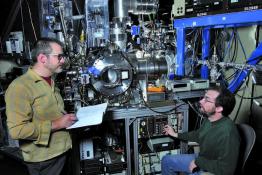Perfluorocarbons (PFCs), some of the immortal molecules in the Earth's atmosphere
Issue 343 | Page 87 | Published Dec 2011
Description
Perfluorocarbons (PFCs) are fully fluorinated hydrocarbons that are used as blood plasma substitutes, in medical imaging and in the cosmetics industry. Most are inert and can also be used as tracers for applications such as air flow. However, because of their bonds and their longevity in the atmosphere, PFCs have large global warming potentials and are a current concern in terms of climate change. At present, their levels in the atmosphere are very low (parts per quadrillion, 1 in 1015) but, once released, they are immortal on human timescales. Measuring such low levels is difficult and methodologies developed by the Atmospheric Chemistry Research Group at the University of Bristol are described.
More from this issue
This article not only highlights the challenges of sustainably harvesting populations of marine invertebrates for their natural products to fuel...
Chemicals entering the atmosphere come from a number of sources but, in broad terms, are either from human activity or from the biosphere (natural...
This article describes the work being undertaken to make more use of supercritical carbon dioxide as a green solvent. It discusses how the use of...



